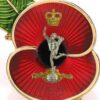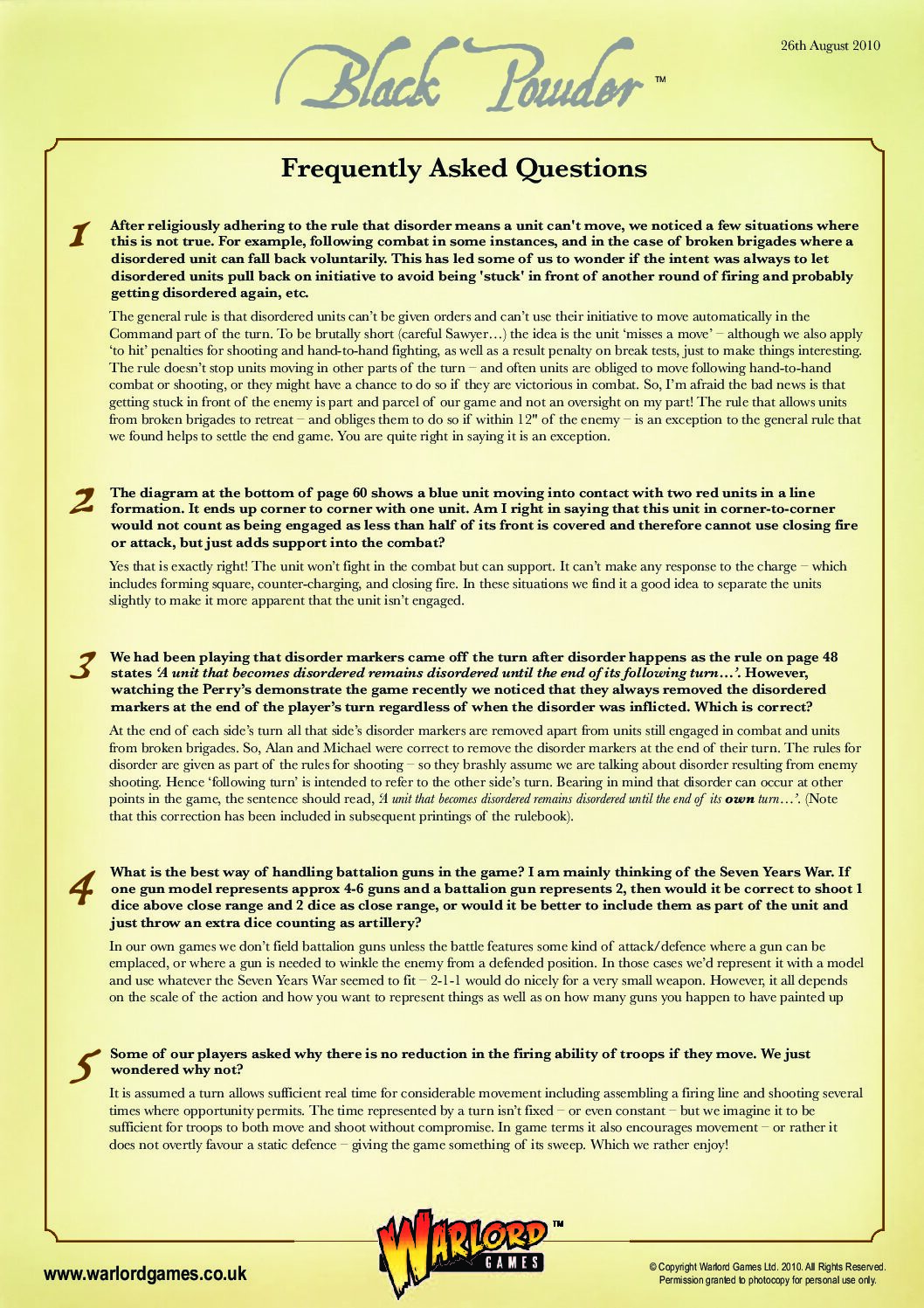Rule Queries
Home › Forums › Historical › Black Powder › Rule Queries
Tagged: Break tests, Closing Fire, Disorderly retire, Proximity, Skirmishers
- This topic has 8 replies, 6 voices, and was last updated 3 years, 9 months ago by
 Big Al.
Big Al.
-
AuthorPosts
-
June 18, 2021 at 9:48 am #185738
arcole
ParticipantHi All,
Third game yesterday which has raised a number of queries:
- 1. Closing fire. Cavalry launched a charge at an artillery battery (whose supportng infantry were busy fighting). In closing fire, the artillery caused 3 casualties, forceing the cavalry to make a break test, which they failed on a net 6. My opponent has found a reference for BP1 suggesting that the test should actually be made as being in shot at. Is does this still apply? If it does apply what happens?
- Skirmishers. A unit of Skirmishing infantry were charged by a cavalry unit. What happens? Does the unit sttempt to form square (the unit had the must form square rule) or does it have to receive the charge at a halt?
- Proximity. A unit in proximity of the enemy can only move within its front or rear arcs. Whilst doing this can it change facing?
- Disorderly retire. Whilst doing this can the unit change its facing?
Thanks in advance
Regards
A.
June 18, 2021 at 12:04 pm #185744 Garry WillsParticipant
Garry WillsParticipantOne of the frustrations associated with BPII is that they did not include the 18 points made in the official 2010 FAQs document, so this document still applies;
Closing Fire: The 2010 FAQs (point 18) distinguished between shaken units which test on the close combat chart and non-shaken units which test on the shooting chart. Personally this is easy to forget in the heat of the action and I usually do all tests for closing fire on the shooting chart.
Skirmisher charge reaction to cavalry; technically they form square because the rules do not exclude skirmishers (p.89) and doesn’t allow them to evade (p.65). It is a bit messy though as skirmishers don’t have flanks or rear (p.24) so will always form square in the face of cavalry charges from any direction. So it is probably better to either remove the form square special rule from your skirmishers or decide that skirmish screens do have flanks which is probably historically more accurate. I tend to go with the latter.
Proximity: yes you can change facing but must stay in the forward and rear sectors – this was confirmed in the 2010 FAQs, Point 16.
Disorderly retreat: The rule specifically states (p.51) that the unit can be oriented to face the enemy during the retreat.
Regards
Garry
June 18, 2021 at 12:48 pm #185745 MarkParticipant
MarkParticipant1. Closing fire counts as Hand to Hand against charges.Therefore, a result of six would see the Cavalry retire one full move and be disordered.
Sorry, don’t have BP2, can’t answer the rest
cheers
June 18, 2021 at 12:50 pm #185746arcole
ParticipantHi Garry,
Thansk for the prompt response.
Regards
A.
June 18, 2021 at 12:59 pm #185747 NatParticipant
NatParticipantOK, not played first edition & I’ve not seen anything that says the v1 FAQ is still valid …so with that in mind I’d answer the questions as:
Closing fire – page 54 makes it clear that the break test is made counting as in combat not being shot at.
[quote] Chargers who suffer so many casualties from closing fire that they are shaken must take a Break Test counting the unit as engaged in combat [\quote]Skirmishers – if the unit has must form square then it will always do so if able. So not if engaged already.
Proximity – well going off page 36 you can change formation but not change your arcs, ie you cant do a left turn and continue marching –
[quote]we oblige units to move more-or-less straight forward, or straight back if they are retreating.[/quote]Disordely Retreat – same as Garry.
June 18, 2021 at 1:23 pm #185748 Garry WillsParticipant
Garry WillsParticipantNat, there are very few differences between the two versions and therefore the same questions get raised. The point about charging and closing fire is a case in point. With the RAW in BP1 and 2 Cavalry will always at least retire when charging the front of artillery unless they get no casualties which is very unlikely with 3 dice at 3+ to hit. This was challenged in BP1 and the FAQ resulted. As I said my biggest disappointment with BP2 is that no one at Warlord bothered to consider their own FAQs when updating the text. Obviously it is up to you whether you choose to use the FAQ but they are certainly worth reading.
Regards
Garry
Attachments:
June 18, 2021 at 3:33 pm #185751Mike
ParticipantI agree with Garry Wills comments with one exception…
I would recommend if you are playing Napoleonics that you go with the Clash of Eagles rules for forming square from skirmish formation. Clash of Eagles recommend that skirmish formation follows the same rules as line formation. These rules basically require a unit to pass a normal command test with some specific rules for increasing the odds based on how far the enemy cavalry unit started its charge and some specific rules that specify what happens when the unit fails to form square.
If you are gaming earlier periods than Napoleonics then you will need to decide what makes sense, light infantry tactics were in a constant stage of revision during the 18th century as they moved from primarily tactics used by irregular troops drawn from border/frontier areas and operating on an army’s flanks during a battle to mainstream tactics used by regulars troops for a host of functions…
“Skirmish” formation is a bit of a misnomer. Since rarely was more than half the unit is “skirmish” order when in open terrain and even in rough terrain a portion of the unit was kept in close order to act as “supports” for skirmishers to fall back on and rally on if suddenly charged by enemy troops. In open terrain, there were close order supports that would operate to “feed” troops into the skirmish line as casualties caused it to thin and a larger reserve to the rear that could feed troops into the close order supports to replenish them in addition to acting as a rallying point and a force to counter attack.
In addition, the reserve acted as the unit’s “command post” from which orders could be issued to the various deployed elements of the battalion. While books love to talk about “clouds” of skirmishers which were used in the early Revolutionary Wars as well as by American militia units in the AWI, such formations were extremely fragile and easy to disperse… one good charge with the bayonets and they unit was scattered with no easy way to reassemble… If I were to “tweak” the rules, I would require at least one quarter to one third of the based to be positioned as “rallying” point for units in skirmish order and require them to be several inches behind the skirmish line… if called for units would form square on this reserve.
Regarding flanks… unlike infantry in line engaged with an enemy to their front, this reserve was not directly “engaged” and most likely would post scouts on its flanks and regardless of formation it would be comprised of a few companies not the whole battalion requiring far less time to execute a formation change, since unlike a unit in “line” forming a hollow square by wheeling companies, the reserve would more likely form of closed square with troops simply packing towards the center and facing outwards…
June 18, 2021 at 4:26 pm #185752 NatParticipant
NatParticipantSo basically you’d take the LI mixed formation rule (from CoE) drop it from 50% to 33% in the Line formation and use that to replace the Skirmish formation on normal and large battalions?
(Small & Tiny formations are representing a company or two so should in theory stay as they are….)
June 29, 2021 at 8:58 am #185817 Big AlParticipant
Big AlParticipantLate to this, but I think most of it has been answered.
Closing Fire break tests always uses the Hand to Hand results.
Skirmishers don’t have a frontage, or rather, count their front as 360 degrees, so will attempt to Form Square. I suppose that they could evade if they were close enough to terrain that the cavalry could not enter. I would allow that as it makes sense.
Proximity allows a unit to change its facing and allows formation changes – unit can expand or contract its frontage.
If you want to change facing and attempt to move whilst iwithin proximity of an enemy, that is your risk. It would require an order because one move is not enough and with the enemy being so close, there is a -1 to command. Next turn could see you charged in a flank on Initiative.
What you cannot do, is change facing, then move, then charge. What I mean is that you cannot move to avoid charging an enemy unit’s front in order to charge the flank. That is the point of the Proximity Rule and there is another rule on charging which prevents it – a unit can only charge the enemy quarter that it begins its turn in. So, if your unit starts it’s turn in the enemy front quarter, it can only charge the enemy front quarter in that turn.
You could move to the flank and then shoot using enfilading fire. BP1 had a photographic example of such a manoeuvre, which Garry will confirm. No point giving page references if you don’t have that book.
All retire moves made as a result of break tests keep the same facing. So, no, they cannot change facing. Besides, they are disordered, so would they know which direction they would want to be facing?
-
AuthorPosts
- You must be logged in to reply to this topic.

